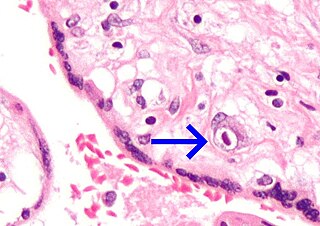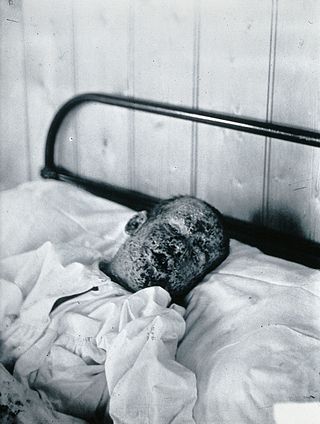Related Research Articles

Safe sex is sexual activity using methods or contraceptive devices to reduce the risk of transmitting or acquiring sexually transmitted infections (STIs), especially HIV. "Safe sex" is also sometimes referred to as safer sex or protected sex to indicate that some safe sex practices do not eliminate STI risks. It is also sometimes used colloquially to describe methods aimed at preventing pregnancy that may or may not also lower STI risks.

Syphilis is a sexually transmitted infection caused by the bacterium Treponema pallidum subspecies pallidum. The signs and symptoms of syphilis vary depending in which of the four stages it presents. The primary stage classically presents with a single chancre though there may be multiple sores. In secondary syphilis, a diffuse rash occurs, which frequently involves the palms of the hands and soles of the feet. There may also be sores in the mouth or vagina. In latent syphilis, which can last for years, there are few or no symptoms. In tertiary syphilis, there are gummas, neurological problems, or heart symptoms. Syphilis has been known as "the great imitator" as it may cause symptoms similar to many other diseases.
Men who have sex with men (MSM) refers to all men who engage in sexual activity with other men, regardless of sexual identity. The term was created by epidemiologists in the 1990s, to better study and communicate the spread of sexually transmitted infections such as HIV/AIDS between all sexually active males, not strictly those identifying as gay or bisexual, but also for example male prostitutes. The term is often used in medical literature and social research to describe such men as a group. It does not describe any specific kind of sexual activity, and which activities are covered by the term depends on context. An alternative term, males who have sex with males is sometimes considered more accurate in cases where those described may not be legal adults.

Congenital syphilis is syphilis that occurs when a mother with untreated syphilis passes the infection to her baby during pregnancy or at birth. It may present in the fetus, infant, or later. Clinical features vary and differ between early onset, that is presentation before age 2-years of age, and late onset, presentation after age 2-years. Infection in the unborn baby may present as poor growth, non-immune hydrops leading to premature birth or loss of the baby, or no signs. Affected newborns mostly initially have no clinical signs. They may be small and irritable. Characteristic features include a rash, fever, large liver and spleen, a runny and congested nose, and inflammation around bone or cartilage. There may be jaundice, large glands, pneumonia, meningitis, warty bumps on genitals, deafness or blindness. Untreated babies that survive the early phase may develop skeletal deformities including deformity of the nose, lower legs, forehead, collar bone, jaw, and cheek bone. There may be a perforated or high arched palate, and recurrent joint disease. Other late signs include linear perioral tears, intellectual disability, hydrocephalus, and juvenile general paresis. Seizures and cranial nerve palsies may first occur in both early and late phases. Eighth nerve palsy, interstitial keratitis and small notched teeth may appear individually or together; known as Hutchinson's triad.

The Pan American Health Organization (PAHO) is a specialized agency of the United Nations (UN) in charge of international health cooperation in the Americas. It fosters technical cooperation among member countries to fight communicable and noncommunicable diseases, strengthen health systems, and respond to emergencies and disasters. It has 35 Member States and four Associate Members in the region. Headquartered in Washington, D.C., PAHO is the regional office for the World Health Organization in the Americas, and the health organization of the Inter-American System. It is known in Latin America as the OPS or OPAS.
HIV/AIDS has been a public health concern for Latin America due to a remaining prevalence of the disease. In 2018 an estimated 2.2 million people had HIV in Latin America and the Caribbean, making the HIV prevalence rate approximately 0.4% in Latin America.

A vertically transmitted infection is an infection caused by pathogenic bacteria or viruses that use mother-to-child transmission, that is, transmission directly from the mother to an embryo, fetus, or baby during pregnancy or childbirth. It can occur when the mother has a pre-existing disease or becomes infected during pregnancy. Nutritional deficiencies may exacerbate the risks of perinatal infections. Vertical transmission is important for the mathematical modelling of infectious diseases, especially for diseases of animals with large litter sizes, as it causes a wave of new infectious individuals.
Jorge Saavedra López is a Mexican who was general director of the Centro Nacional para la Prevencion y el Control del VIH/SIDA (CENSIDA), an agency of the Mexican Ministry of Health. And since January 2018, he is the executive director of the AHF Global Public Health Institute at the University of Miami.
Marcos Espinal is currently the Director of the Department of Communicable Diseases and Health Analysis at the Pan American Health Organization (PAHO), Regional Office for the Americas of the World Health Organization (WHO). Dr Espinal's portfolio includes several areas of work: neglected, tropical & vector-borne diseases; risk and outbreak communication; HIV, Hepatitis, Tuberculosis & STIs; health information & analysis; water & sanitation, and veterinary public health.

The eradication of infectious diseases is the reduction of an infectious disease's prevalence in the global host population to zero.

A sexually transmitted infection (STI), also referred to as a sexually transmitted disease (STD) and the older term venereal disease (VD), is an infection that is spread by sexual activity, especially vaginal intercourse, anal sex, or oral sex. STIs often do not initially cause symptoms, which results in a risk of passing the infection on to others. Symptoms and signs of STIs may include vaginal discharge, penile discharge, ulcers on or around the genitals, and pelvic pain. Some STIs can cause infertility.
HIV/AIDS in Bolivia has a less than 1 percent prevalence of Bolivia's adult population estimated to be HIV-positive. Bolivia has one of the lowest HIV prevalence rates in the Latin America and Caribbean region.
Cases of HIV/AIDS in Peru are considered to have reached the level of a concentrated epidemic.
Honduras is the Central American country most adversely affected by the HIV/AIDS epidemic. It is estimated that the prevalence of HIV among Honduran adults is 1.5%.

Syphilis is a bacterial infection transmitted by sexual contact and is believed to have infected 12 million people in 1999 with greater than 90% of cases in the developing world. It affects between 700,000 and 1.6 million pregnancies a year, resulting in spontaneous abortions, stillbirths, and congenital syphilis. In Sub-Saharan Africa syphilis contributes to approximately 20% of perinatal deaths.
Jon Andrus, an American physician, epidemiologist and immunization specialist, is the former deputy director of the Pan American Health Organization (PAHO).
Malaria Day in the Americas is commemorated annually on November 6 to promote awareness, recognize past and current efforts to prevent and control malaria in the region of the Americas, build commitment, and to mobilize action to advance malaria goals and targets as the region works towards elimination. Awareness of this disease is very important in the region of the Americas, where an estimated 120 million people in 21 endemic countries are at risk of malaria. In 2012, there were 469,000 confirmed malaria cases in the region with 108 deaths. Nonetheless, declining incidence of disease and malaria-related mortality has led to low prioritization of malaria on national health agendas in the Americas.

Neonatal infections are infections of the neonate (newborn) acquired during prenatal development or within the first four weeks of life. Neonatal infections may be contracted by mother to child transmission, in the birth canal during childbirth, or after birth. Neonatal infections may present soon after delivery, or take several weeks to show symptoms. Some neonatal infections such as HIV, hepatitis B, and malaria do not become apparent until much later. Signs and symptoms of infection may include respiratory distress, temperature instability, irritability, poor feeding, failure to thrive, persistent crying and skin rashes.

The Catholic Medical Mission Board (CMMB) is an international, faith-based NGO, providing long-term, co-operative medical and development aid to communities affected by poverty and healthcare issues. It was established in 1912 and officially registered in 1928. CMMB is headquartered in New York City, USA, and currently has country offices in Haiti, Kenya, Peru, South Sudan, and Zambia.
References
- ↑ "PAHO/WHO | Eliminación de la transmisión maternoinfantil del VIH y de la SC en ALC: Documento conceptual". Pan American Health Organization / World Health Organization. Retrieved 2021-02-26.
- ↑ HIV/STI Plan for the Health Sector 2006-2015 (PAHO, 2005)
- ↑ "Eliminatio of Congenital Syphilis in the Americas(PAHO, 2005)" (PDF). Archived from the original (PDF) on 2011-07-27. Retrieved 2010-07-18.
- ↑ CARICOM Health Ministers Launch Regional Initiative for HIV and Syphilis Free Generations
- ↑ "PAHO/WHO | Eliminación de la transmisión maternoinfantil del VIH y de la SC en ALC: Documento conceptual". Pan American Health Organization / World Health Organization. Retrieved 2021-02-26.
- ↑ "PAHO/WHO | Guía clínica para la eliminación de la transmisión maternoinfantil del VIH y de la sífilis congénita". Pan American Health Organization / World Health Organization. Retrieved 2021-02-26.
- ↑ Regional Initiative for the Elimination of Mother-to-Child Transmission of HIV and CS in LAC: Regional Monitoring Strategy
- ↑ The Global Fund 2010: Innovation and Impact, Geneva, Switzerland. Archived 2010-12-04 at the Wayback Machine
- ↑ PMTCT STRATEGIC VISION 2010–2015: Preventing mother-to-child transmission of HIV to reach the UNGASS and Millennium Development Goals (WHO, 2010).